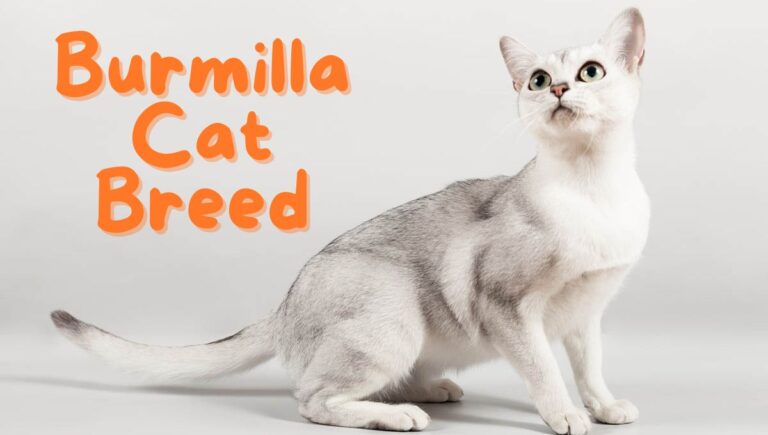Birman Cat Breed
Introduction :
The Birman cat, also known as the “Sacred Cat of Burma,” is a breed with a rich and somewhat mystical history. Believed to have originated in Burma (modern-day Myanmar), these cats were considered sacred companions to temple priests.
Their journey to the Western world began in the early 20th century, and they have since become a beloved breed known for their striking appearance and gentle disposition.
The name “Birman” is derived from “Burma,” the country of the breed’s origin. The breed’s full name, “Sacred Cat of Burma,” reflects its historical and cultural significance in its native land, where it was revered and surrounded by legend.

Birmans are medium to large-sized cats with a robust and muscular build. They are most notable for their distinctive color-point pattern, similar to that of the Siamese, with darker colors on their ears, face, paws, and tail.
Their semi-long fur is silky and requires less grooming than other long-haired breeds due to its texture, which is less prone to matting.
The coat is usually a pale cream or fawn with contrasting darker points. One of the most captivating features of the Birman cat is its deep blue, almost sapphire-colored eyes, which are both expressive and enchanting.
A unique and defining characteristic of the Birman breed is their “gloves” – pure white paws that look like they are wearing gloves or socks. The symmetry and evenness of these gloves are often a point of focus in breed standards.
Birmans are known for their affectionate and friendly nature. They are social cats that enjoy the company of humans and other animals. Their gentle demeanor makes them excellent companions for families and individuals alike. While Birmans are calm and composed, they are also intelligent and enjoy interactive play.
They can be quite curious and are known to engage in playful behavior well into adulthood. Overall, the Birman cat breed combines striking physical features with a warm and engaging personality, making it a unique and cherished member of the feline world.
Table of Contents
I. Origin and History of Birman Cat Breed :
Origins and Historical Significance :
- Geographical Region of Origin
- The Birman cat, also known as the “Sacred Cat of Burma,” is believed to have originated in Burma (modern-day Myanmar).
- The breed’s name, “Birman,” is derived from the French word for Burma, reflecting its Asian roots.
- Breeds Involved in Formation
- The exact breeds that played a role in the formation of the Birman are not definitively known due to its ancient and somewhat mysterious origins.
- It’s speculated that the Birman may have developed from crossbreeding between local Burmese cats and long-haired cats, possibly introduced by travelers or traders.
Characteristics Influenced by Origin :
- Appearance
- The Birman cat is known for its striking blue eyes, silky semi-long coat, and distinctive color points (darker coloration on the face, ears, paws, and tail) similar to the Siamese.
- Each Birman has white “gloves” on their paws, a unique feature that is thought to be influenced by selective breeding over generations.
- Temperament
- The breed is noted for its gentle and affectionate nature, which may be linked to its history of being a revered temple cat in Burma.
- Birmans are known for their calm demeanor and strong bond with humans, possibly a trait that was nurtured in their sacred role.
Folklore and Legends :
- Temple Cats and Sacred Duties
- According to legend, Birmans were the companions of Kittah priests in Burmese temples.
- One popular story tells of a priest named Mun-Ha and his cat, Sinh. When Mun-Ha was attacked and killed, Sinh placed his paws on his fallen master and faced the temple goddess. Sinh’s white coat turned golden, and his eyes turned blue like the goddess’s, while his paws remained white as a symbol of purity.
- Divine Transformation
- This transformation was seen as a divine sign, and all temple cats were believed to have acquired these characteristics.
- The cats were considered sacred and thought to carry the souls of priests to the afterlife, reinforcing their importance in religious ceremonies.
European Introduction and Modern Development :
- Introduction to Europe
- The Birman was first introduced to Europe in the early 20th century, with varying accounts of how the first pair arrived in France. One popular account suggests that a pair of Birmans was gifted to French nationals as a gesture of gratitude for aiding temple priests.
- Breed Development and Recognition
- The breed was nearly lost during World War II, with only a few individuals surviving. However, dedicated breeding programs in France and other parts of Europe helped to reestablish the Birman.
- The Birman gained recognition from various cat fancier organizations over time, solidifying its status as a distinct and cherished breed.
Modern Characteristics :
- Distinctive Features
- The Birman’s white gloves, silky coat, and blue eyes remain defining features, closely tied to the breed’s storied past.
- Today’s Birmans are bred to maintain these characteristics, honoring the breed’s historical and legendary origins.
- Temperament and Popularity
- Birmans are popular pets worldwide due to their friendly and affectionate nature, making them excellent companions.
- Their historical association with temples and legends contributes to their mystique and appeal, further cementing their place in modern cat fancy.
The Birman cat breed’s origins are rich with history and legend, from its sacred role in Burmese temples to its near extinction and subsequent revival in Europe. The breed’s unique characteristics, such as its white gloves and blue eyes, are deeply rooted in its storied past, making the Birman not only a visually striking cat but also a living piece of cultural heritage.

II. Physical Characteristic of Birman Cats :
| Height | Birmans are medium to large-sized cats, typically ranging from 12 to 16 inches (30 to 40 centimeters) in height at the shoulder. |
| Weight | The ideal weight for a Birman cat is between 8 to 12 pounds (3.5 to 5.5 kilograms) for males and slightly less for females. |
| Life Span | On average, Birmans live between 12 to 16 years, though some individuals may live even longer with proper care. |
| Good With | Birmans are known for their friendly and sociable nature, making them great companions for families, children, other pets, and even elderly individuals. |
| Temperament | Birmans are gentle, affectionate, and easy-going cats. They enjoy human company and are known for their calm demeanor. |
| Intelligence | Birmans are intelligent cats that can be trained to learn tricks and respond to their owners. They have a curious nature and enjoy interactive play. |
| Shedding Amount | Birmans have a moderate shedding tendency. While they do shed, their semi-long, silky fur is less prone to matting compared to some other long-haired breeds. |
| Grooming | Weekly grooming sessions are usually sufficient to keep a Birman’s coat healthy and free of mats. They enjoy being groomed and often see it as a bonding activity with their owners. |
| Exercise Needs | While Birmans are not overly active cats, they do enjoy playtime and interactive toys. Providing them with opportunities for play and exercise helps keep them mentally and physically stimulated. |
| Energy Level | Birmans have a moderate energy level. They are not hyperactive but enjoy occasional bursts of playfulness. |
| Meowing Level | Birmans are not particularly vocal cats. They may meow occasionally to communicate with their owners but are generally quiet compared to some other breeds. |
| Drool amount | Birmans are not known to be excessive droolers. They typically keep themselves clean and groomed. |
| Coat Length/Texture | Birmans have a semi-long, silky coat that is soft to the touch. Their fur is less prone to matting due to its texture. |
| Colors | The traditional coloration of Birmans is a pale cream or fawn body with darker points on the ears, face, paws, and tail. However, they come in a variety of colors, including seal, blue, chocolate, lilac, red, cream, and tortie. |
| Patterns | Birmans typically have a color-point pattern similar to Siamese cats, where the points are darker than the body color. The contrast between the body color and the points creates their distinctive appearance. |
Detailed Physical Characteristic of the Birman Cat Breed :
The Birman breed exhibits a distinctive combination of size, coat type, color variations, and unique physical traits that set it apart from other breeds.
Size :
Birmans are medium to large-sized cats, with males typically being larger than females. On average, males stand around 12 to 16 inches (30 to 40 centimeters) tall at the shoulder, while females are slightly smaller.
Weight Ranges :
- Males: 8 to 12 pounds (3.5 to 5.5 kilograms)
- Females: Slightly less than males, usually ranging from 6 to 10 pounds (2.7 to 4.5 kilograms)
Coat Type :
Birmans have a semi-longhaired coat that is silky in texture and luxurious to the touch. Their fur is less prone to matting compared to some other long-haired breeds.
Color Variations :
While the traditional Birman is known for its pale cream or fawn body with darker points on the ears, face, paws, and tail, the breed comes in a variety of colors, including:
- Seal: Dark brown points on a lighter body.
- Blue: Grayish-blue points on a lighter body.
- Chocolate: Light brown points on a lighter body.
- Lilac: Pinkish-gray points on a lighter body.
- Red: Reddish points on a lighter body.
- Cream: Cream-colored points on a lighter body.
- Tortie: Tortoiseshell pattern with points of various colors.
Coat Texture and Length :
The Birman’s coat is semi-long and silky in texture. It requires regular grooming to prevent mats and tangles, but its texture makes it less prone to matting compared to some other long-haired breeds.
Common Color Patterns :
Birmans typically exhibit a color-point pattern, where the points (ears, face, paws, and tail) are darker than the body color. The contrast between the body color and the points creates their distinctive appearance.
Distinctive Features :
- White “Gloves”: One of the most distinctive features of the Birman breed is their pure white paws, known as “gloves.” These white markings extend evenly up the legs, giving the appearance of the cat wearing gloves or socks.
- Blue Eyes: Birmans have striking deep blue eyes that are captivating and expressive.
- Facial Markings: Birmans often have symmetrical facial markings, such as a “blaze” or white stripe on their noses and “spectacles” around their eyes.
- Medium-sized Ears and Tail: Birmans have medium-sized ears that are neither too large nor too small, and their tails are medium in length, proportionate to their body size.
These distinctive physical features, along with their gentle temperament and affectionate nature, make the Birman breed a unique and cherished member of the feline world.

III. Temperament and Personality of Birman Cats :
The Birman breed is renowned for its gentle temperament and affectionate personality, making it a beloved choice for families and individuals alike. Here’s an outline of the typical temperament and personality traits of Birmans, along with some common behavioral traits associated with the breed:
Typical Temperament and Personality Traits :
- Gentle Demeanor: Birmans are known for their calm and composed demeanor. They are not overly assertive or aggressive, preferring instead to approach situations with a gentle disposition.
- Affectionate: Birmans are incredibly affectionate cats that form strong bonds with their human companions. They enjoy being close to their owners, often seeking out cuddles and lap time.
- Sociable: Birmans are social cats that enjoy the company of both humans and other animals. They thrive in households where they receive plenty of attention and interaction.
- Playful: Despite their calm nature, Birmans have a playful side and enjoy interactive play sessions with toys or their human companions. This playful behavior continues into adulthood, making them engaging pets.
- Intelligent: Birmans are intelligent cats that can learn tricks and respond to training. They enjoy mental stimulation and benefit from activities that engage their minds.
Common Behavioral Traits :
- Attention-Seeking: Birmans crave attention and may follow their owners around the house or vocalize to seek interaction. They may become distressed if left alone for extended periods.
- Social Butterflies: Birmans do not like to be left out of family activities and may try to involve themselves in whatever their humans are doing. This can sometimes lead to “helpful” behavior that may interfere with tasks.
- Sensitive: Birmans are sensitive cats that can be affected by changes in their environment or routine. They may become anxious or stressed in unfamiliar situations.
- Relaxed Disposition: Birmans are generally laid-back cats that adapt well to indoor living. They are not as demanding or high-energy as some other breeds, making them suitable for households with a more tranquil lifestyle.
Managing and Addressing Breed Specific Behavioral Issues :
- Provide Enrichment: Keep Birmans mentally stimulated with interactive toys, puzzle feeders, and play sessions. This helps prevent boredom and reduces the likelihood of behavioral problems.
- Maintain Consistency: Birmans thrive on routine, so try to keep their environment and daily schedule as consistent as possible. This can help reduce stress and anxiety.
- Socialization: Introduce Birmans to new people, animals, and experiences gradually to help them feel more comfortable and confident in different situations.
- Positive Reinforcement: Use positive reinforcement techniques, such as treats and praise, to encourage desired behaviors and discourage unwanted ones.
- Provide Attention: Spend quality time with your Birman each day, offering cuddles, playtime, and affection to fulfill their social needs and strengthen your bond.
Overall, by understanding and accommodating the unique temperament and behavioral traits of Birmans, you can create a harmonious and fulfilling relationship with these wonderful cats.
IV. Care and Maintenance of Birman Cat Breed :
Taking care of a Birman cat involves addressing their grooming needs, health considerations, nutrition, and exercise requirements. Here’s a breakdown of each aspect:
Grooming Needs :
Birmans have a semi-long, silky coat that requires regular grooming to keep it healthy and free of mats. Here are some grooming tips:
- Brushing: Brush your Birman’s coat at least once a week to remove loose hair and prevent matting. Use a soft-bristled brush or a stainless steel comb.
- Bathing: Birmans are generally fastidious self-groomers and rarely need baths. However, if your cat gets dirty or oily, you can bathe them occasionally using a mild cat shampoo.
- Nail Trimming: Trim your cat’s nails every few weeks to prevent them from becoming too long and causing discomfort or snagging on furniture.
- Ear Cleaning: Check your Birman’s ears regularly for signs of wax buildup or infection. Clean them gently with a damp cotton ball if necessary, but avoid inserting anything into the ear canal.
Health Consideration :
While Birmans are generally healthy cats, they may be prone to certain health issues common in many cat breeds. Regular veterinary check-ups can help detect and address any health concerns early. Some health considerations for Birmans include:
- Heart Disease: Birmans may be predisposed to hypertrophic cardiomyopathy (HCM), a form of heart disease. Regular cardiac screenings by a veterinarian are recommended.
- Oral Health: Like many breeds, Birmans can be prone to dental issues such as tartar buildup and gum disease. Regular dental care, including brushing your cat’s teeth and providing dental treats or toys, can help maintain oral health.
- Obesity: Birmans can be prone to obesity if overfed or under-exercised. Monitor your cat’s weight and provide a balanced diet along with regular play and exercise to prevent obesity-related health problems.
Nutrition :
Provide your Birman with a balanced diet formulated specifically for their life stage (kitten, adult, senior) and activity level. Choose high-quality cat food that contains essential nutrients such as protein, vitamins, and minerals. Monitor your cat’s weight and adjust their food intake as needed to maintain a healthy weight.
Exercise :
While Birmans are not as high-energy as some other breeds, they still benefit from regular exercise to maintain their physical and mental health. Provide opportunities for play and interactive toys to keep your Birman entertained and active. Schedule daily play sessions and engage your cat in activities that mimic natural behaviors, such as hunting and climbing.
By addressing your Birman’s grooming needs, health considerations, nutrition, and exercise requirements, you can help ensure that they lead a happy, healthy, and fulfilling life as part of your family. Regular veterinary care and attention to your cat’s overall well-being will contribute to their longevity and quality of life.

V. Suitability of Birman Cats :
Compatibility with Children and Other Animals :
Birman cats are generally well-suited for families with children and get along well with other pets. Here’s an assessment of their compatibility:
- Children: Birmans are known for their gentle and affectionate nature, making them great companions for children. They are patient and tolerant, even in the face of a child’s playful antics. However, it’s essential to teach children how to interact respectfully with cats, including handling them gently and understanding their body language.
- Other Pets: Birmans are typically friendly and sociable cats that can coexist peacefully with other pets, including dogs and other cats. They are not particularly territorial and are often willing to share their space with other animals.
Special Considerations for Multi-Pet Households :
When introducing a Birman to an existing multi-pet household, it’s essential to proceed gradually and carefully to ensure a smooth transition. Here are some tips:
- Slow Introduction: Allow your existing pets to become familiar with the scent of the new cat before introducing them face-to-face. Start by exchanging bedding or toys between pets to help them acclimate to each other’s scent.
- Supervised Interactions: Initially, supervise interactions between your Birman and other pets to ensure they get along well. Keep interactions positive and rewarding, and intervene if any conflicts arise.
- Provide Separate Spaces: Ensure that each pet has its own space where they can retreat and feel safe. This can help prevent tension and territorial disputes.
- Positive Reinforcement: Reward good behavior and interactions between pets with treats and praise. Encourage positive associations to help foster harmony in the household.
Environmental Needs :
Birmans adapt well to indoor living and do not have any specific environmental requirements beyond those typical for cats. Here are some considerations:
- Space: While Birmans don’t require a large amount of space, they do appreciate having areas to explore and climb. Providing cat trees or shelves can satisfy their natural instincts to perch and observe their surroundings.
- Temperature: Birmans are comfortable in standard room temperatures and do not require any special environmental conditions. Ensure that your home is kept at a comfortable temperature year-round.
- Safety: Keep your Birman safe by ensuring that your home is free of hazards such as toxic plants, small objects that could be swallowed, and open windows or balconies. Provide access to fresh water and a clean litter box at all times.
By considering the breed’s compatibility with children and other pets, as well as any special considerations for multi-pet households and environmental needs, you can ensure that your Birman settles in well and thrives in your home environment.
VI. Adoption and Breeder Consideration of Birman Cat Breed :
Adoption from Shelters or Rescue Organizations :
Adopting a Birman cat from a shelter or rescue organization is a wonderful way to provide a loving home to a cat in need. Here are some benefits of adoption:
- Saving a Life: By adopting from a shelter or rescue, you’re giving a cat a second chance at life. Many cats in shelters are in need of loving homes and may face euthanasia if not adopted.
- Supporting Rescue Efforts: Adoption supports the efforts of shelters and rescue organizations that work tirelessly to rescue, rehabilitate, and rehome cats. Your adoption fee helps cover the costs of care, including spaying/neutering, vaccinations, and medical treatments.
- Finding the Right Fit: Shelters and rescues often have a variety of cats available for adoption, including Birmans. You can meet different cats and find one whose personality and needs align with your lifestyle.
- Gratitude and Loyalty: Adopted cats often show immense gratitude and loyalty to their new families. Many rescue cats form strong bonds with their adopters and become cherished members of the family.
Selecting a Reputable Breeder :
If you choose to purchase a purebred Birman from a breeder, it’s essential to select a reputable breeder who prioritizes the health and well-being of their cats. Here’s what to look for in a breeder:
- Ethical Breeding Practices: A reputable breeder will prioritize the health and temperament of their cats over profit. They will follow ethical breeding practices and provide proper care for their breeding cats and kittens.
- Health Screenings: The breeder should conduct health screenings on their breeding cats to screen for genetic diseases and conditions common in the Birman breed, such as hypertrophic cardiomyopathy (HCM). Ask the breeder for documentation of health screenings and genetic testing.
- Socialization and Environment: The kittens should be raised in a clean and socialized environment, with plenty of interaction and exposure to different stimuli. A responsible breeder will ensure that the kittens are well-socialized and ready for life in their new homes.
Cost Consideration and Potential Adoption Fees :
The cost of adopting or purchasing a Birman cat can vary depending on several factors, including location, breeder reputation, and whether the cat is purebred or mixed breed. Here are some cost considerations:
- Adoption Fees: Adoption fees for cats from shelters or rescue organizations typically range from $50 to $200. These fees often include spaying/neutering, vaccinations, microchipping, and sometimes other services such as deworming and flea treatment.
- Breeder Prices: The cost of purchasing a purebred Birman kitten from a reputable breeder can range from $500 to $2000 or more, depending on factors such as pedigree, lineage, and show quality.
- Additional Expenses: In addition to the initial adoption or purchase cost, consider ongoing expenses such as food, litter, veterinary care, grooming supplies, and toys.
When considering adoption or purchasing from a breeder, it’s important to weigh the financial aspects along with other factors such as the cat’s health, temperament, and suitability for your lifestyle. Whether you choose to adopt or purchase, providing a loving and responsible home for a Birman cat is a rewarding experience.

VII. Conclusion
The Birman cat breed is adored for its enchanting appearance and gentle nature, embodying a unique blend of striking physical features and affectionate temperament. With their semi-long, silky coat adorned in a color-point pattern and captivating blue eyes, Birmans possess an unmistakable allure. Beyond their aesthetics, Birmans are known for their calm and loving disposition, making them cherished companions for families and individuals seeking a feline friend. Their sociable nature and playful demeanor add to their charm, fostering strong bonds with their human companions and other pets.
Responsible ownership is paramount when considering bringing a Birman cat into one’s home. It entails a commitment to meeting the cat’s needs throughout its life, from providing proper nutrition and veterinary care to ensuring regular grooming and mental stimulation. Prospective owners should take the time to understand the breed’s specific requirements and temperamental traits, enabling them to create an environment where their Birman can thrive. Whether opting for adoption from a shelter or purchasing from a reputable breeder, selecting a source that prioritizes the well-being of the cats and adheres to ethical breeding practices is crucial.
Welcoming a Birman cat into one’s life is a decision that warrants careful consideration of all aspects of pet ownership. While the joys of companionship and the beauty of the breed are undeniable, it’s essential to approach the commitment with diligence and dedication. By embracing responsible ownership practices and providing a loving and nurturing environment, prospective owners can ensure a fulfilling and harmonious relationship with their Birman companion for years to come.
FAQ about Birman Cat Breed :
What is the average lifespan of a Birman cat?
Birman cats have an average lifespan of around 12 to 16 years, though some individuals may live even longer with proper care and attention to their health needs.
Are Birman cats prone to any specific health issues?
While Birmans are generally healthy cats, they may be predisposed to certain health conditions common in many cat breeds, such as hypertrophic cardiomyopathy (HCM), a form of heart disease. Regular veterinary check-ups can help detect and address any health concerns early.
Do Birman cats get along with other pets?
Birmans are social cats that typically get along well with other pets, including dogs and other cats. They are not particularly territorial and are often willing to share their space with other animals.
Are Birman cats suitable for families with children?
Yes, Birmans are generally gentle and affectionate cats that are well-suited for families with children. They have a calm demeanor and enjoy the company of humans, including children, making them excellent companions for families.
What is the origin of the Birman cat breed?
The Birman cat breed is believed to have originated in Burma (modern-day Myanmar), where they were revered as sacred companions to temple priests. They made their way to the Western world in the early 20th century, gaining popularity for their striking appearance and gentle demeanor.







